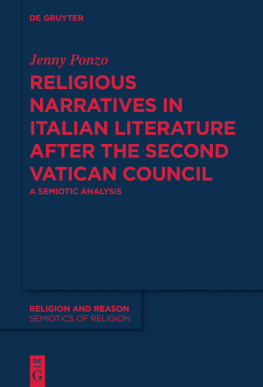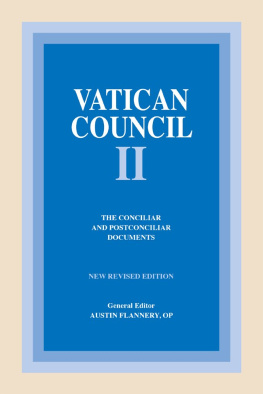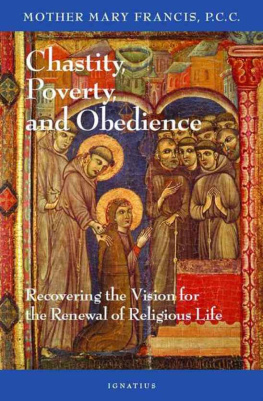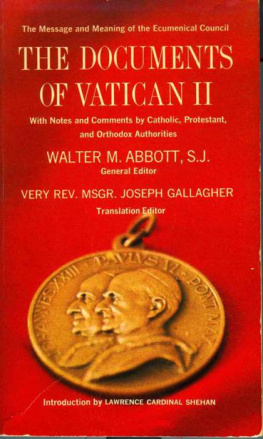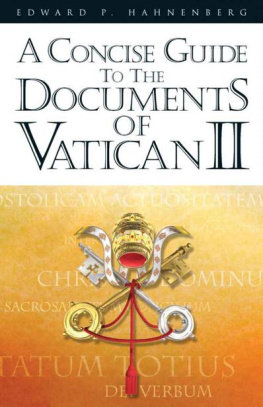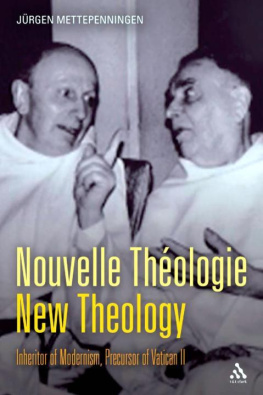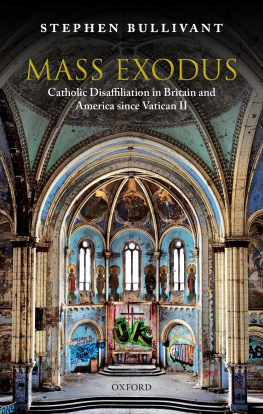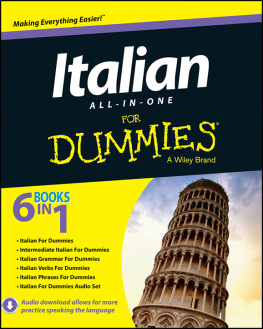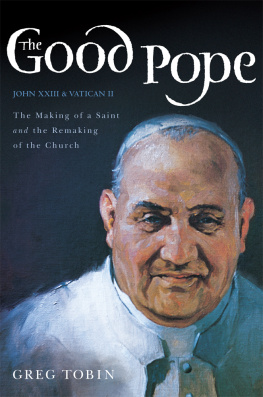Contents
Guide

Jenny Ponzo
Religious Narratives in Italian Literature after the Second Vatican Council
Religion and Reason
Founded by Jacques Waardenberg
Edited by
Gustavo Benavides, Michael Strausberg,
and Ann Taves
Volume 59

Semiotics of Religion
Edited by
Massimo Leone, Fabio Rambelli, and Robert Yelle
Volume 2

ISBN 978-3-11-049984-1
e-ISBN (PDF) 978-3-11-049783-0
e-ISBN (EPUB) 978-3-11-049602-4
Library of Congress Control Number 2018968025
Bibliographic information published by the Deutsche Nationalbibliothek
The Deutsche Nationalbibliothek lists this publication in the Deutsche Nationalbibliografie;
detailed bibliographic data are available on the Internet at http://dnb.dnb.de.
2019 Walter de Gruyter GmbH, Berlin/Boston
www.degruyter.com
Acknowledgements
This book presents a study initiated in 2014 when I was awarded an LMU Research Fellowship at the Ludwig-Maximilians-University Munich (Germany). I wish to thank this institution, Robert Yelle (chair of the Interfaculty Programme for the Study of Religion, where I was affiliated), and Angelika Mooser-Sainer for her administrative support.
After the end of the LMU Research Fellowship, I continued to work on this book in the frame of my project NeMoSanctI New Models of Sanctity in Italy (1960s-2010s), which has received funding from the European Research Council (ERC) under the European Unions Horizon 2020 research and innovation programme (grant agreement No. 757314).
NeMoSanctI is hosted by the Department of Philosophy and Educational Sciences of the University of Turin. A special thank you to Ugo Volli (former Department Dean for Research) and Donatella Mutti for their dedication in following and accompanying the first steps of the project at the Unversity of Turin.
Introduction
La littrature est un dvoilement de lhomme
et du monde, disait Sartre; et il avait raison.
Elle ne serait rien si elle ne nous permettait
pas de mieux comprendre la vie.
Todorov (1984: 188)
The aim of this book is to study a sample of recurring religious themes in Italian fiction published after the Second Vatican Council (19621965). This chronological point of reference has been chosen due to the innovative character of the Council and its significant repercussions in Italian culture. Indeed, the Second Vatican Council constitutes a key moment in the history of Catholicism in which the Church, after carefully examining the contemporary situation, firmly took a stance in favor of modernity and encouraged practitioners to adapt her traditions to the new needs of contemporary society. The research presented herein explores some facets of the post-conciliar religious sensibility such as it is expressed in literature. As the analysis reveals, there are several controversial aspects of religious concepts that have ancient roots but have assumed a peculiar character in light of the new positions adopted by the Church. In particular, this book investigates the complex set of ideas expressed by Italian writers about the biblical narration of human origins and traditional religious language and ritual, the perceived clash between the immanent and transcendent nature and role of the Church, and the problematic notion of sanctity emerging from contemporary narrative. The method adopted for this study of a wide corpus of narrative texts mostly novels is inspired by semiotics, including both its linguistic and narratological branches.
a The Second Vatican Council and literature
In the 20 th and 21 st centuries, Catholicism has been obliged to face the growth of alternative and competing worldviews entailing ideas, values, and narratives that differ profoundly from those presented in Church tradition. The Roman Church herself has undergone important internal changes the main expression of which is the policy of aggiornamento sanctioned by the Second Vatican Council. In particular, the conciliar Fathers ascertained that Profound and rapid changes are spreading by degrees around the whole world. Triggered by the intelligence and creative energies of man, these changes recoil upon him, upon his decisions and desires [] and upon his manner of thinking and acting with respect to things and to people ( Gaudium et Spes 1965: n. 4). According to this view, a new secular mentality accompanying a period of growing upheaval led people to abandon God and religion: Unlike in former days, the denial of God or of religion, or the abandonment of them, are no longer unusual and individual occurrences. For today it is not rare for such things to be presented as requirements of scientific progress or of a certain new humanism. In numerous places these views are voiced not only in the teachings of philosophers, but on every side they influence literature, the arts []. As a consequence, many people are shaken ( Gaudium et Spes 1965: n. 7).
In response to increasing secularization, the Roman Catholic Church announced a policy of aggiornamento or adaptation of her traditional teachings to the modern world. Just as the Church identified the impact of secularization on literature and the arts, a part of her response consisted of seeking to transform these aesthetic media as a necessary component of the mission of salvation. The most obvious aspect of this semiotic shift was the vernacularization of the mass. More than a simple act of translation, this shift also reflected a new way of thinking about signs and communication, not only between the Church and her members (and non-members) but also between the deity and human beings.
Moreover, the Second Vatican Council issued its own prescriptions about artistic expression. In the constitution about liturgy Sacrosanctum Concilium (1963), the Church strongly emphasizes that content be prioritized over form (i.e. the semantic function, see Yelle: forthcoming). While The Church has not adopted any particular style of art as her very own ( Sacrosanctum Concilium 1963: n. 123), it does provide precise guidelines concerning the message and goal of the arts: [The fine] arts, by their very nature, are oriented toward the infinite beauty of God which they attempt in some way to portray by the work of human hands; they achieve their purpose of redounding to Gods praise and glory in proportion as they are directed the more exclusively to the single aim of turning mens minds devoutly toward God ( Sacrosanctum Concilium 1963: n. 122). The question is to what extent such ideas have been translated into the domain of secular Italian literature.
b The relationship between Italian literature and Catholicism
In Italy, significant percentage of people still define themselves as Catholic, albeit not in an orthodox or integral way; in addition, the Catholic worldview continues to play an important role in Italian culture and imagery with the result that even those who define themselves as non-believers end up engaging with this religious tradition as one of the components of their cultural background (Garelli 2014). In this general context, the relationship between Italian writers and religion is often complex.
On the one hand, there has been a rather powerful anticlerical intellectual tradition in Italy, in particular dating to the period of Italian nation-state formation (1861) and the Churchs loss of temporal power (1870). Since that time literature has increasingly sought to overcome the direct influence of Catholic religion and doctrine (Segre 2005; Dalmas 2013). On the other hand, a number of writers openly took up Catholic positions in the second half of the 20 th century and were active exponents of the Christian Democracy party (e.g. Rodolfo Doni, Eugenio Corti). Moreover, a number of critics and scholars have pointed out that 20 th century Italian literature featuring Catholic motifs maintains a mid- or low profile and does not include masterpieces in the same way as, for instance, French literature (see e.g. Getto 1967 and Dalmas 2013). The literary quality of works featuring catholic motifs is not particularly relevant for the purpose of this book, and neither are the political and religious positions adopted by individual writers. The research presented here consists neither in an evaluation of the artistic value of the works under consideration nor in an enquiry into the thoughts and faith of authors, but rather in a study of several recurring ideas expressed in these works.

